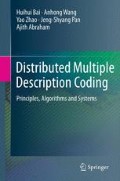Abstract
DVC is the important application of DSC for video coding. This chapter introduces the relative information theory of DSC. Then, on the basis of these corresponding theories, one of the most significant principles of DSC, that is, Slepian–Wolf coding is presented based on Turbo and LDPC, respectively. Finally, the performance of Slepian–Wolf coding is analyzed in detail.
Access this chapter
Tax calculation will be finalised at checkout
Purchases are for personal use only
References
Slepian, D., Wolf, J.K.: Noiseless coding of correlated information sources. IEEE Trans. Inf. Theory 19(4), 471–480 (1973)
Wyner, A., Ziv, J.: The rate-distortion function for source coding with side information at the decoder. IEEE Trans. Inf. Theory 22(1), 1–10 (1976)
Zamir, R.: The rate loss in the Wyner-Ziv problem. IEEE Trans. Inf. Theory 42(6), 2073–2084 (1996)
Griod, B., Aaron, A., Rane, S.: Distributed video coding. Proc. IEEE 93(1), 71–83 (2005)
Gallager, R.G.: Low density parity codes. IEEE Trans. Inf. Theory IT-8, 21–28 (1962)
Richardsom, T., Urbanke, R.: Efficient encoding of low-density parity-parity codes. IEEE Trans. Inf. Theory 47(2), 638–656 (2001)
Davey, M.C., MacKay, D.J.C.: Low density parity-parity codes over GF (q). IEEE Commun. Lett. 2, 165–167 (1998)
Schonberg, D., Pradhan, S.S., Ramchandran, K.: LDPC codes can approach the Slepian-Wolf bound for general binary sources. In: Proceedings of Allerton Conference on Communication, Control, and Computing, Allerton, IL (2002)
Leveris, A., Xiong, Z., Geolrghiades, C.: Compression of binary sources with side information at the decoder using LDPC codes. IEEE Commun. Lett. 6(10), 440–442 (2002)
Varodayan, D., Aaron, A., Girod, B.: Rate-adaptive distributed source coding using low-density parity-check codes. In: Proceedings of Asilomar Conference on Signals, Systems and Computers, Pacific Grove, pp. 1–8 (2005)
Author information
Authors and Affiliations
Corresponding author
Rights and permissions
Copyright information
© 2011 Springer-Verlag London Limited
About this chapter
Cite this chapter
Bai, H., Wang, A., Zhao, Y., Pan, JS., Abraham, A. (2011). Principles of DVC. In: Distributed Multiple Description Coding. Springer, London. https://doi.org/10.1007/978-1-4471-2248-7_3
Download citation
DOI: https://doi.org/10.1007/978-1-4471-2248-7_3
Published:
Publisher Name: Springer, London
Print ISBN: 978-1-4471-2247-0
Online ISBN: 978-1-4471-2248-7
eBook Packages: Computer ScienceComputer Science (R0)

